![]()

Roxy Theatre, New York City, New York - January 14, 1928
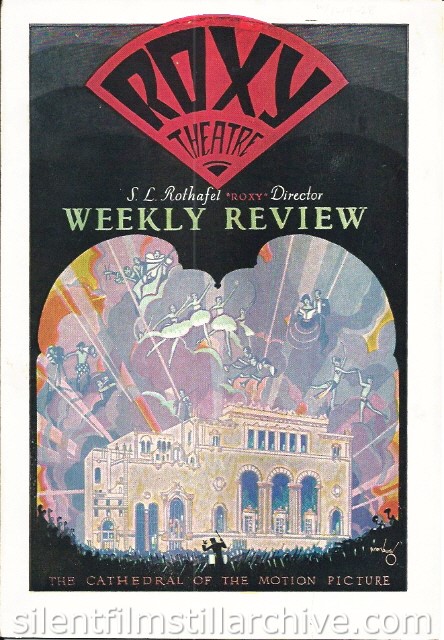
ROXY THEATRE
S. L. Rothafel "ROXY" Director
WEEKLY REVIEW
THE CATHEDRAL OF THE MOTION PICTURE
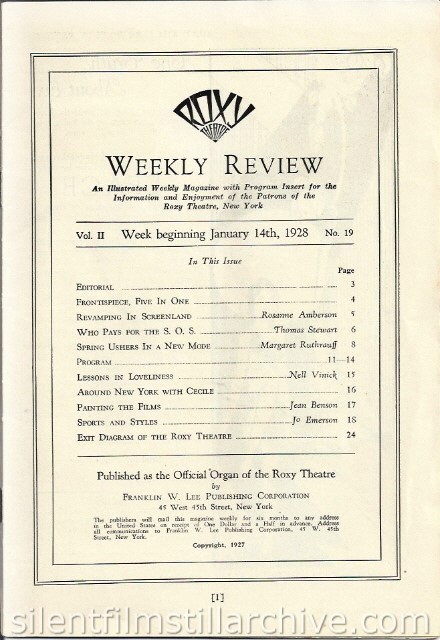
Roxy Theatre
Weekly Review
An Illustrated Weedly Magazine with Program insert for the Information and Enjoyment of the Patrons of the Roxy Theatre, New York
Vol. II Week beginning January 14, 1928 No. 19
In This Issue
EDITORIAL ..... Page 3
FRONTISPIECE, FIVE IN ONE ..... 4
REVAMPING IN SCREENLAND ..... Rosanne Amberson 5
WHO PAYS FOR THE S. O. S. ..... Thomas Stewart 6
SPRING USHERS IN A NEW MODE ..... Margaret Ruthrauff 8
PROGRAM ..... 11-14
LESSONS IN LOVELINESS ..... Nell Vinick 15
AROUND NEW YORK WITH CECILE ..... 16
PAINTING THE FILMS ..... Jean Benson 17
SPORTS AND STYLES ..... Jo Emerson 18
EXIT DIAGRAM OF THE ROXY THEATRE ..... 24
Published as the Official Organ of the Roxy Theatre
by
FRANKLIN W. LEE PUBLISHING CORPORATION
45 West 45th Street, New York
The publishers will mail this magazine weekly for six months to any address in the United States on receipt of One dillar and a Half in advance. Address all communications to Franklin W. Lee Publishing Corporation, 45 W. 45th Street, New York.
Copyright, 1927
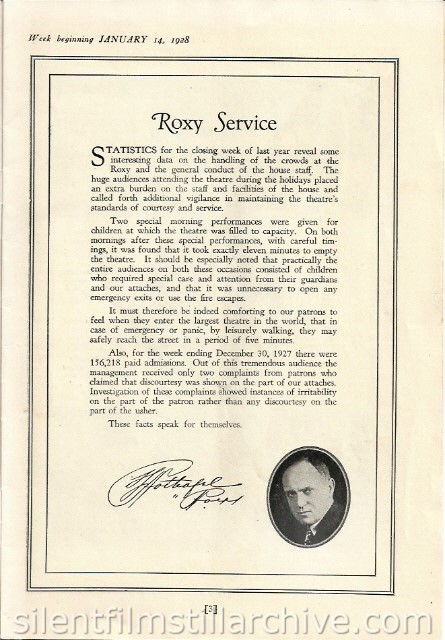
Roxy Service
STATISTICS for the closing week of last year reveal some interesting data on the handling of the crowds at the Roxy and the general conduct of the house staff. The huge audiences attending the theatre during the holidays placed an extra burden on the staff and facilities of the house and called forth additional vigilance in maintaining the theatre's standards of courtesy and service.
Two special morning performances were given for children at which the theatre was filled to capacity. On both mornings after these special performances, with careful timings, it was found that it took exactly eleven minutes to empty the theatre. It should be especially noted that practically the entire audiences on both these occasions concicted of children who required special care and attention from their guardiand and our attaches, and that it was unnecessary to open any emergency exits or use the fire escapes.
It must therefore be indeed comforting to our patrons to feel when they enter the largest theatre in the world, that in case of emergency or panic, by leisurely walking, they may safely reach the street in a period of five minutes.
Also, for the week ending December 30, 1927 there were 156,218 paid admissions. Out of this tremendous audience the management received only two complaints from patrons who claimed that discourtesy was shown on the part of our attaches. Investigation of these complaints showed instances of irritability on the part of the patron rather than any discourtesy on the part of the usher.
These facts speak for themselves.
Rothafel "Roxy"
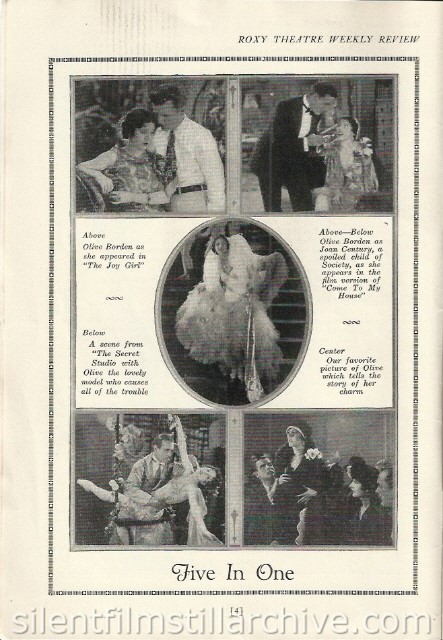
Above (left) Olive Borden as she appeared in "The Joy Girl"
Below (left) A scene from "the Secret Studio with Olive the lovely model who causes all of the trouble.
Above -- Below (right) Olive Borden as Joan Century, a spoiled child of Society, as she appears in the film version of "Come To My House"
Center Our favorite picture of Olive which tells the story of her charm
Five In One
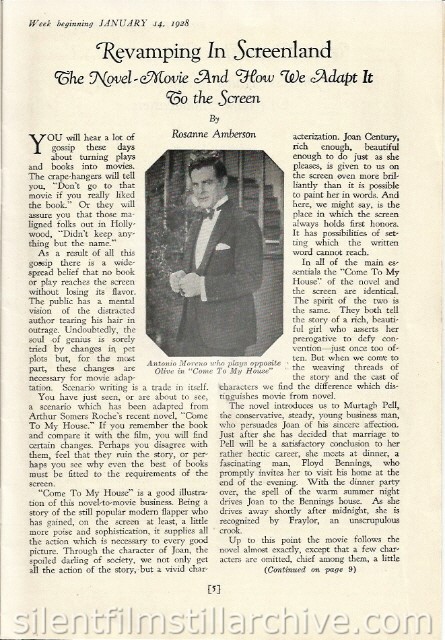
Revamping In Screenland
the Novel-Movie and How We Adapt It To the Screen
By Rosanne Amberson
YOU will hear a lot of gossip these days about turning plays and books into movies. The crepe-hangers will tell you, "Don't go to that movie if you really liked the book." Or they will assure you that those maligned folks out in Hollywood, "Didn't keep anything but the name."
As a result of all this gossip there is a wide-spread belief that no book or play reaches the screen without losing its flavor. The public has a mental vision of the distracted author tearing his hair in outrage. undoubtedly, the soul of genius is sorely tried by changes in pet plots but, for the most part, these changes are necessary for movie adaptation. Scenario writing is a trade in itself.
You have just seen, or are about to see, a scenario which has been adapted from Arthur Somers Roche's recent novel, "Come To My House." If you remember the book and compare it with the film, you will find certain changes. Perhaps you disagree with them, feel that they ruin the story, or perhaps you see why even the best of books must be fitted to the requirements of the screen.
"Come To My House" is a good illustrationof this novel-to-movie business. Being a story of the still popular modern flapper who has gained, on the screen at least, a little more poise and sophistication, it supplies all the action which is necessary to every good picture. Through the character of Joan, the spoiled darling of society, we not only get all the action of the story, but a vivid characterization. Joan Century, rich enough, beautiful enough to do just as she pleases, is given to us on the screen even more brilliantly than it is possible to paint her in words. And here, we may say, is the place in which the screen always holds first honors. It has possibilities of setting which the written word cannot reach.
In all of the main essentials the "Come To My House" of the novel and the screen are identical. The spirit of the two is the same. They both tell the story of a rich, beautiful girl who asserts her perogative to defy convention -- just once too often. But when we come to the weaving threads of the story and the cast of characters we find the difference which distinguishes movie from novel.
The novel introduces us to Murtagh Pell, the conservative, stead, young business man, who persuades Joan of his sincere affection. Just after she has decided that marriage to Pell will be a satisfactory conclusion to her rather hectic career, she meets at dinner, a fascinating man, Floyd Bennings, who promptly invites her to visit his home at the end of the evening. With the dinner party over, the spell of the warm supper night drives Joan to the Bennings house. As she drives away shortly after midnight, she is recognized by Fraylor, an unscrupulous crook.
Up to this point the movie follows the novel almost exactly, except that a fwe characters are omitted, chief among them, a little (Continuted on page 9)
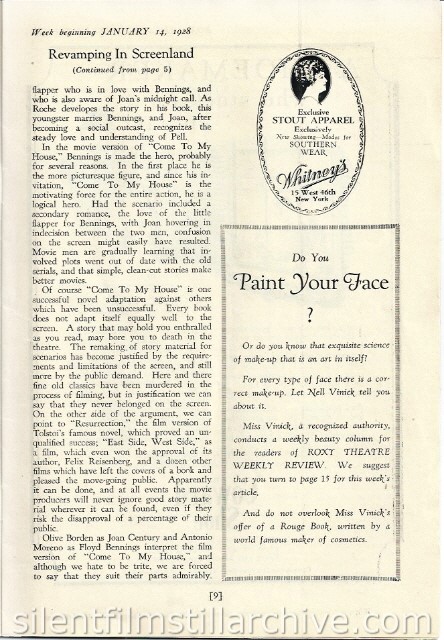
Revamping In Screenland
(Continued from page 5)
flapper who is in love with Bennings, and who is also aware of Joan's midnight call. As roche developes (sic) the story in his book, this youngster marries Bennings, and Joan, after becoming a social outcast, recognizes the steady love and understanding of Pell.
In the movie verions of "Come To My House," Bennings is made the hero, probably for several reasons. In the first place he is the more picturesque figure, and since his invitiation, "Come to my House" is the motivating fource for the entire action, he is a logical hero. had the scenario included a secondary reomance, the love of the little flapper for Bennings, with Joan hovering in indecision between the two men, confusion on the screen might easily have resulted. Movie men are gradually learning that involved plots went out of date with the old serials, and that simple, clean-cut stories make better movies.
Of course "Come To My Mouse" is one successful novel adaptation against others which have been unsuccessful. Every book does not adapt itself equally well to the screen. A story that may hold you enthralled as your read, may bore you to death in the theatre. The remaking of story material for scenarios has become justified by the requirements and limitations of the screen, and still more by the public demand. Here and there fine old classics have been murdered in the process of filming, but in justification we can say that they never belonged on the screen. On the other side of the argument, we can point to "Resurection," the film version of Tolstoi's famous novel, which proved an unqualified success; East Side, West Side," as a film, which even won the approval of its author, Felix Reisenber, and a dozen other films which have left the covers of a book and pleased the move-going (sic) public. Apparently it can be done, and at all events the movie producers will never ignore good story material wherever it can be found, even if they risk the disapproval of a percentage of thier public.
Olive Borden as Joan Century and Antonio Moreno as Floyd Bennings interpret the film version of "Come To My House," and although we hate to be trite, we are forced to say that they suit their parts admirably.
Exclusive
STOUT APPAREL
Exclusively
New Showing -- Modes for SOUTHERN WEAR
Whitney's
15th West 46th
New York
Do You Paint Your Face?
Or do you know that exquisite science of make-up that is an art in
itself?
For every type of face there is a correct make-up. Let nell Vinick tell
you about it.
Miss Vinick, a recognized authority, conducts a weekly beauty column for
the readers of ROXY THEATRE WEEKLY REVIEW. We suggest that you turn to
page 15 for this weeks article
And do not overlook Miss Vinick's offer of a rouge book, written by a
world famous maker of cosmetics.
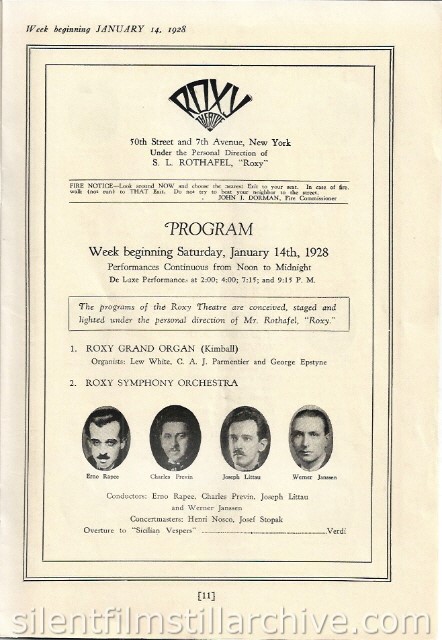
ROXY THEATRE
50th Street and 7th Avenue
Under the Personal direction of S. L. ROTHAFEL, "Roxy"
Fire Notice -- Look around NOW and choose the nearest Exit to your seat.
In case of fire, walk (not run) to THAT Exit. Do not try to beat your
neighbor to the street.
JOHN J. DORMAN, Fire Commissioner
PROGRAM
Week Beginning Saturday, January 14th, 1928
Performances Continuous from Noon to Midnight
De Luxe performances at 2:00; 4:00; 7:15; and 9:15 P.M.
The programs of the Roxy Theatre are conceived, staged and lighted under the personal direction of Mr. Rothafel, "Roxy."
1. ROXY GRAND ORGAN (Kimball)
Organists: Lew White, C. A. J. Parmentier and George Epstyne
2. ROXY SYMPHONY ORCHESTRA
Erno Rapee Charles Previn Joseph Littau Werner Janssen
Conductors: Erno Rapee, Charles Previn, Joseph Littau and Werner Janssen
Concertmasters: Henri Nosco, Josef Stopak
Overture to "Sicilian Vespers" .......... Verdi
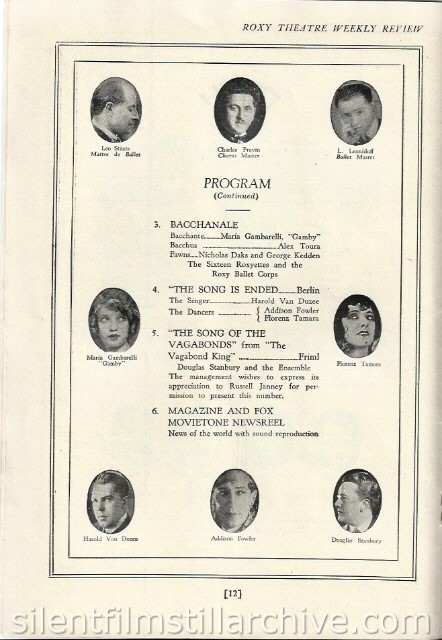
PROGRAM
(Continued)
Leo Staats Maitre de Ballet
Charles Previn Chorus Master
L. Leonidoff Ballet Master
3. BACCHANALE
Bacchante .......... Maria Bambarelli, "Gamb"
Bacchus .......... Alex Toura
Fawns .......... Nicholas Kaks and George Kedden
The Sixteen Roxyettes and the Roxy Ballet Corps
4. "THE SONG IS ENDED" .......... Berlin
The Singer .......... Harold Van Duzee
The Dancers .......... Addison Fowler
.......... Florenz Tamara
5. "THE SONG OF THE VAGAONDS" from "The Vagabond King" .......... Friml
Douglas Stanbury and the Ensemble
The management wishes to express its appreciation to Russell janey for
permission to present this number.
6. MAGAZINE AND FOX MOVIETONE NEWSREEL
News of the world with sound reproduction
Maria Gambarelli "Gamby"
Florenz Tamara
Harold Van Duzee
Addison Fowler
Douglas Stanbury
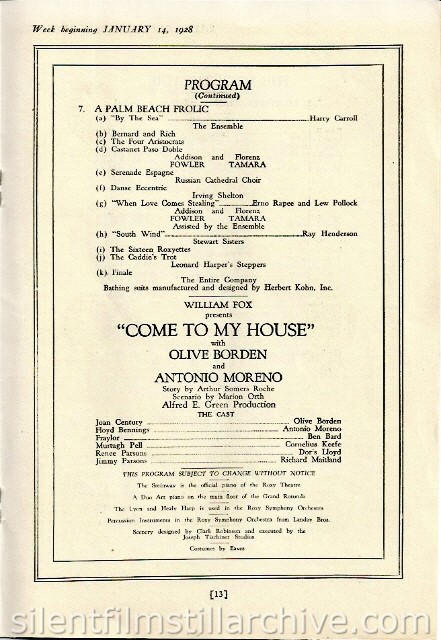
PROGRAM
(Continued)
7. A PALM BEACH FROLIC
(a) "By The Sea" ..........Harry Carroll
The Ensemble
(b) Bernard and Rich
(c) The Four Aristocrats
(d) Castanet Paso Doble
Addison FOWLER and Florenz TAMARA
(e) Serenade Espagne
Russian Cathedral Choir
(f) Danse Eccentric
Irving Shelton
(g) "When Love Comes Stealing" .......... Erno Rapee and Lew Pollock
Addison FOWLER and Florenz TAMARA
Assisted by the Ensenble
(h) "South Wind" .......... Ray henderson
Stewart Sisters
(i) The Sixteen Roxyettes
(j) The Caddie's Trot
Leonard Harper's Steppers
(k) Finale
The Entire Company
Bathing suits manufactured and designed by Herbert Kohn, Inc.
WILLIAM FOX
presents
"COME TO MY HOUSE"
with
OLIVE BORDEN
and
ANTONIO MORENO
Story by Arthur Somers Roche
Scenario by Marion Orth
Alfred E. Green Production
THE CAST
|
Joan Century |
Olive Borden |
|
Floyd Bennings |
Antonio Moreno |
|
Fraylor |
Ben Bard |
|
Murtaugh Pell |
Cornelius Keefe |
|
Renee Parsons |
Doris Lloyd |
|
Jimmy Parsons |
Richard Maitland |
THIS PROGRAM SUBJECT TO CHANGE WITHOUT NOTICE
The Steinway is the official piano of the Roxy Theatre
A Duo Art piano on themain floor of the Grand Rotunda
The Lyon and Healy Harp is used in the Roxy Symphony Orchestra
Percussion Instruments in the Roxy Symphony Orchestra from Landay Bros.
Scenery designed by Clark Robinson and executed by the Joseph Teichner Studios
Costumes by Eaves
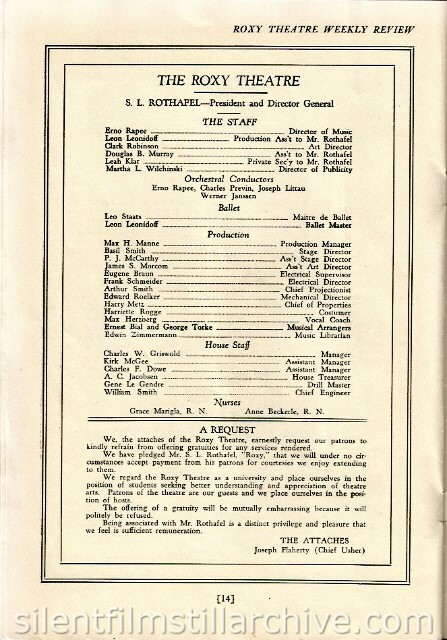
The Roxy Theatre
S. L. ROTHAFEL - President and Director General
STAFF
|
Erno Rapee |
Director of Music |
|
Leon Leonidoff |
Production Ass't to Mr. Rothafel |
|
Clark Robinson |
Art Director |
|
Douglas B. Murray |
Ass't to Mr. Rothafel |
|
Leah Klar |
Private Sec'y to Mr. Rothafel |
|
Martha L. Wilchinski |
Director of Publicity |
Orchestral Conductors
Erno Rapee, Charles Previn, Joseph Littau
Werner Janssen
Ballet
|
Leon Staats |
Maitre de Ballet |
|
Leon Leonidoff |
Ballet Master |
Production
|
Max H. Manne |
Production Manager |
|
Basil Smith |
Stage Director |
|
P. J. McCarthy |
Ass't Stage Director |
|
James S. Morcom |
Ass't Art Director |
|
Eugene Braun |
Electrical Supervisor |
|
Frank Schmeider |
Electrical Director |
|
Arthur Smith |
Chief Projectionist |
|
Edward Roelker |
Mechanical Director |
|
Harry Metz |
Chief of Properties |
|
Harriette Rogge |
Costumer |
|
Max Herzberg |
Vocal Coach |
|
Ernest Bial and George Torke |
Musical Arrangers |
|
Edwin Zimmermann |
Music Librarian |
House Staff
|
Charles W. Griswold |
Manager |
|
Kirk McGee |
Assistant Manager |
|
Charles F. Dowe |
Assistant Manager |
|
A. C. Jacobson |
House Treasurer |
|
Gene Le Gendre |
Drill Master |
|
William Smith |
Chief Engineer |
Nurses
|
Grace Marigla, R. N. |
Anne Beckerle, R. N. |
A REQUEST
We, the attaches of the Roxy Theatre, earnestly request our patrons to kindly refrain from offering gratuities for any services rendered.
We have pledged Mr. S. L. Rothafel, "Roxy" that we will under no circumstances accept payment from his patrons for courtesies we enjoy extending to them.
We regard the Roxy Theatre as a university and place ourselves in the position of students seeking better understand and appreciation of theatre arts. Patrons of the theatre are our guests and we place ourselves in the position of hosts.
The offering of a gratuity will be mutually embarrassing because it will be politely be refused.
Being associated with Mr. Rothafel is a distinct privilege and pleasure that we feels is sufficient remuneration.
THE ATTACHES -- Joseph Flaherty (Chief Usher)
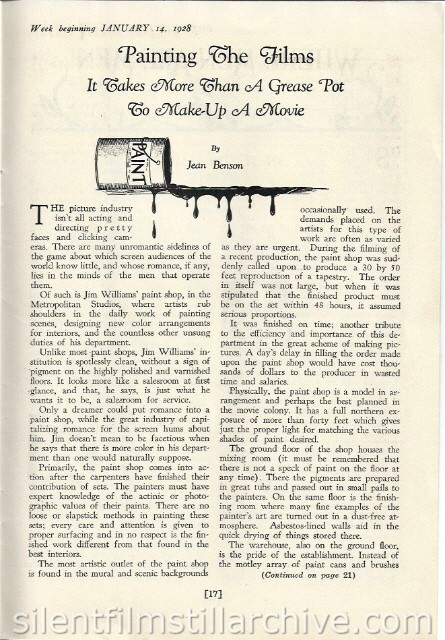
Painting The Films
It Takes More than a Grease Pot to Make-Up a Movie
by Jean Benson
THE picture industry isn't all acting and directing pretty faces and clicking cameras. There are many unromantic sidelines of the game about which screen audiences of the world know little, and whose romance, if any, lies in the minds of the men that operate them.
Of such is Jim williams' paint shop, in the Metropolitan Studios, where artists rub shoulders in the daily work of painting scenes, sedigning new color arrangements for interiors, and the countless other unsung duties of his department.
Unlike most paint shops, Jim Williams' institution is spotlessly clean, without a sign of pigmenton the highly polished and varnished floors. it looks more like a salesroom at first glance, and that, he says, is just what he want it to be, a salesroom for service.
Only a dreamer could put romance into a paint shop, while the great industry of capitalizing romance for the screen hums about him. Jim doesn't mean to be facetious when he says that there is more color in his department than one would naturally suppose.
Primarily, the paint shop comes into action after the carpenters have finished their contribution of sets. The painters must have expert knowledge of the actinic or photographic values of their paints. There are no loose or slapstick methods in painting these sets; every care and attention is given to proper surfacing and in no respect is the finished work different from that found in the best interiors.
The most artistic outlet of the paint shop is found in the mural and scenic backgrounds occasionally used. The demands placed on the artists for this type of work are often as varied as they are urgent. During the filming of a recent production,the paint shop was suddenly called upon to produce a 30 by 50 feet reproduction of a tapestry. The order in itself was not large, but when it was stipulated that the finished product must be on the set within 48 hours, it assumed serious proportions.
It was finished on time; another tribute to the efficiency and importance of this department in the great scheme of making pictures. A day's delay in filling the order mad upon the paint shop would have cost thousand of dollars to the producer in wasted time and salaries.
Physically, the paint show is a model in arrangement and perhaps the best planned in the movie colony. It has a full northern exposure of more than forty feet which gives just the proper light for matching the various shades of paint desired.
The ground floor of the shop houses the mixing room (it must be remembered that there is not a speck of paint on the floor at any time). There the pigments are prepared in great tubs and passed out in small pails to the painters. One the same floor is the finishing room where many fine examples of the painter's art are turned out in a dust-free atmosphere. Asbestos-lined walls aid in the quick drying of things stored there.
The warehouse, also on the ground floor, is the pride of the establishment. Instead of the motly array of paint cans and brushes (Continued on page 21)
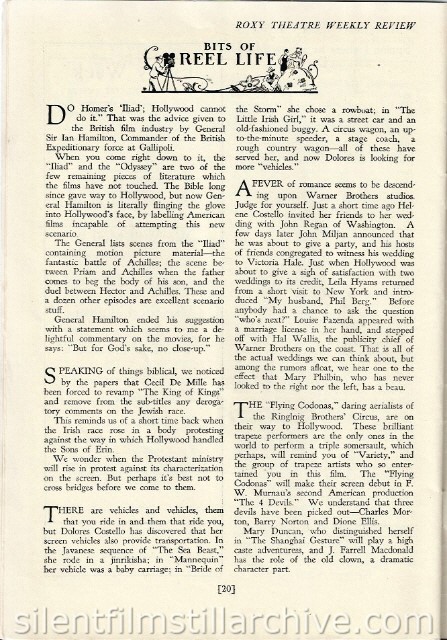
BITS OF REEL LIFE
Do Homer's 'Iliad': Hollywood cannot do it." That was the advice given to the British film industry by General Sir Ian Hamilton, Commander of the British Expeditionary Force at Gallipoli.
When you come right down to it, the "Iliad" and the "Odyssey" are two of the few remaining pieces of literature which the films have not touched. The Bible long since gave way to Hollywood, but now General Hamilton is literally flinging the glove into Hollywood's face, by labelling American films incapable of attempting this new scenario.
The General lists scenes from the "Illiad" containing motion picture material -- the fantastic battle of Achilles; the scene between Priam and Achilles when the father comes to beg the body of his son, and the dual between Hector and Achilles. These and a dozen other episodes are excellent scenario stuff.
General Hamilton ended his suggestion with a statement which seems to me a delightful commentary on the movies, for he says: "But for God's sake, no close-up."
SPEAKING of things biblical, we noticed by the papers that Cecil De mille has been forced to revamp "The King of Kings" and remove from the sub-titles any derogatory comments on the Jewish race.
This reminds us of a short time back when the Irish race rose in a body protesting against the way in which Hollywood handled the Sons of Erin.
We wonder when the Protestant ministry will rise in protest against its characterization on the screen. But perhaps it's best not to cross bridges before we come to them.
There are vehicles and vehicles, them that you ride in and them that ride you, but Dolores Costello has discovered that her screen vehicles also provide transportation. In the Javanese sequence of "The Sea Beast," she rode in a jinrikish; in "Mannequin" her vehicle was a baby carriage; in "Bride of the Storm" she chose a rowboat; in "The Little Irish Girl," it was a street car and old-fashioned buggy. A circus wagon, an up-to-the-minute speeder, a stage coach, a rough country wagon -- all of these have served her, and now Dolores is looking for more "vehicles.
A FEVER of romance seems to be descending upon Warner Brothers studios. Judge for yourself. Just a short time ago Helene Costello invited her friends to her wedding with John Regan of Washington. A few days later John Miljan announced that he was about to give a party, and his hosts of friends congregated to witness his wedding to Victoria Hale. Just when Hollywood was about to give a sigh of satisfaction with two weddings to its credit, Leila hyams returned from a short visit to new York and introduced "My husband, Phil Berg." Before anybody had a chance to ask the question "who's next?" Louise Fazenda appeared with a marriage license in her hand, and stepped of with Hal Wallis, the publicity chief of Warner Brothers on the coast. This is all of the actual weddings we can think about, but among the rumors afloat, we hear one to the effect that Mary Philbin, who has never looked to the right nor the left, has a beau.
THE "Flying Codonas," daring aerialists of the Ringling Brothers' Circus, are on their way to Hollywood. These brilliant trapeze performers are the only ones in the world to perform a triple somersault, which perhaps, will remind you of "Variety," and the group of trapeze artists who so entertained you in this film. The "Flying Codonas" will make their screen debut in F. W. Murnau's second American production "The 4 Devils." We understand that three devils have been picked out -- Charles Morton, Barry Norton and Dione Ellis.
Mary Duncan, who distinguished herself in "The Shanghai Gesture" will play a high caste adventuress, and J. Farrell Macdonald has the role of the old clown, a dramatic character part.
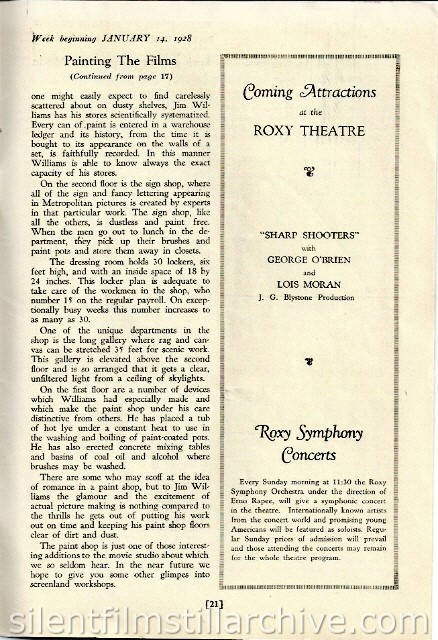
Painting The Films
(continued from page 17)
one might easily expect to find carelessly scattered about on dusty shelves, Jim Williams has his stores scientifically systematized. Every can of paint is entered in a warehouse ledger and its history, from the time is is bought to its appearance on the walls of a set, is faithfully recorded. In this manner Williams is able to know always the exact capacity of his stores.
On the second floor is the sign shop, where all of the sign and fancy lettering appearing in Metropolitan pictures is created by experts in that particular work. The sign shop, like all the others, is dustless and paint free. When the men go out to lunch in the department, they pick up their brushes and paint pots and store them away in closets.
The dressing room holds 30 lockers, six feet high, and with an inside space of 18 by 24 inches. This locker plan is adequate to take care of the workmen in the shop, who number 15 on the regular payroll. On exceptionally busy weeks this number increases to as many as 30.
One of the unique departments in the shop is the long gallery where rag and canvas can be stretched 35 feet for scenic work. this gallery is elevated above the second floor and is so arranged that it gets a clear, unfiltered light from a ceiling of skylights.
On the first floor are a number of devices which Williams had especially made and which make the paint shop under his care distinctive from others. He has placed a tub of hot lye under a constant heat to use in the washing and boiling of paint-coated pots. He has also erected concrete mising tables and basins of coal oil and alcohol where brushes may be washed.
There are some who may scoff at the idea of romance in a paint shot, but to Jim Williams the glamour and the excitement of actual picture making is nothing compared to the thrills he gets out of putting his work out on time and keeping his paint shop floors clear of dirt and dust.
The paint shop is just one of those interesting additions to the movie studio about which we so seldom hear. In the near future we hope to give you some other glimpes (sic) into screenland workshops.
Coming Attractions
at the
ROXY THEATRE
"SHARP SHOOTERS"
with
GEORGE O'BRIEN
and
LOIS MORAN
J. G. Blystone Production
Roxy Symphony Concerts
Every Sunday morning at 11:30 the Roxy Symphony Orchestra under the direction of Erno Rapee, will give a symphonic concert in the theatre. Internationally known artists from the concert world and promising young Americans will be featured as soloists. Regular Sunday prices of admission will prevail and those attending the concerts may remain for the whole theatre program.
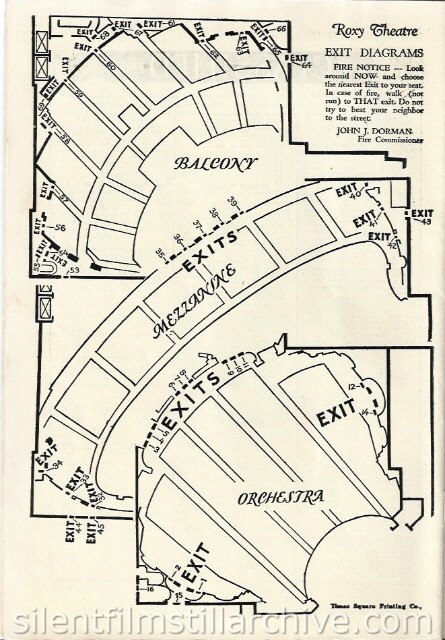
Roxy Theatre
EXIT DIAGRAMS
FIRE NOTICE -- Look around NOW and choose the nearest Exit to your seat. In case of fire, walk (not run) to THAT exit. Do not try to beat your neighbor to the street.
JOHN J. DORMAN (Fire Commissioner)
Times Square Printing Co.
More Information on the Roxy Theatre...
The Roxy Theatre at CinemaTreasures.com
Last Modified June 16, 2015














